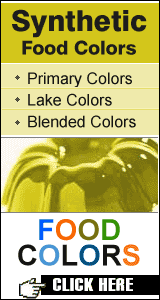The color of food is an integral part of our culture
and enjoyment of life. They have been used to enhance the aesthetic value of
foods. In the early civilizations like of the Romans and the Egyptians, food
color was used in candies and beverages. Saffron, turmeric and paprika etc
were the traditional food colorants. The use of colorants in cosmetics can
be traced to the early Egyptian transcripts.
Today all food color additives are carefully regulated by federal
authorities to ensure that foods are safe to eat and accurately labeled.
Butter has been colored yellow as far back as the 1300s.
In nineteenth century, synthetic organic dyes were developed creating, a
more economical and wider range of colorants. Since then their quality has
been improved due extensive research and development.
Certifiable synthetic color additives are preferred over the natural for
their coloring ability. They need to be added in smaller quantities, are
more stable and provide a wide range of hues. Certifiable color additives
generally do not impart undesirable flavors to foods, while color derived
from foods such as beets and cranberries can produce such unintended
effects.
Reasons For Food Coloring
- To make up the color loss due to light, air, temperature,
moisture and storage
- To correct natural variations in color
- To enhance the natural colors associated with a given product.
- To provide a colorful identity to the colorless or dull looking
foods.
- To provide a colorful appearance to "fun foods."
- To protect flavors and vitamins that may be affected by
sunlight.
|




